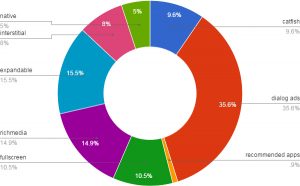Effective traffic monetization is the problem that almost every mobile site or application owner faces at one time or another.
In this case, we will talk about the publishers that use automated platforms and have all the controls over the choice of ad formats displayed on their website or in an app.
Often publishers choose ad formats that just feel right to them. However, this strategy is not always successful, because the reality of mobile monetization is more complex. The effective choice of ad formats should be data-driven and substantiated by evidence.
What is an efficient ad format?
This question is more tricky than might seem at first, as the answer depends on the point of view and the criteria taken into consideration.
Currently, we’re defining the ad format efficiency according to its ability to make profits for the publisher and help monetize the site traffic. The measurement we use in this case is the number of clicks the ad gets. It is harder to account for the correlation between the number of leads and the particular ad formats, because such factors as reviews and app ratings could be more important than CR in this case.
Which ad formats do publishers choose?
Having studied 500 randomly selected mobile sites, we discovered the most popular formats according to site and app owners: catfish (31.1% of owners prefer this format), native (27.3%) and full screen (13.5%). The least popular ones are dialog ads (8.1% of site owners use such ads), recommended apps (6.7%), rich media (5.2%), expandable (4.6%) and interstitial ads (3.5%).
However, when we compared the assumptions of the publishers on the popularity of the ad formats with the actual results of the campaigns conducted , we found out that the two did not always coincide.
Which ad formats did show the best results?
During the campaigns, the ad formats demonstrated the following CTR:
Catfish — 2.33%, dialog ads — 8.66%, recommended apps — 0.22%, fullscreen — 2.55%, rich media — 3.63%, expandable — 3.78%, interstitial — 1.96%, and native — 1.22%.
Eventually, the highest CTR was observed in expandable and rich media formats, while the formats more frequently chosen by publishers, such as native and catfish, demonstrated only below average results.
The following figures show the clickability distribution for each of the ad formats:
To sum up, the rating of the most popular ad formats among the publishers is the following:
- Catfish
- Native
- Fullscreen
- Dialog ads
- Recommended apps
- Rich media
- Expandable
- Interstitial
However, the order of the actually the most benefitting formats is next:
- Dialog ads
- Expandable
- Rich media
- Fullscreen
- Catfish
- Interstitial
- Native
- Recommended apps
Conclusions
This research is not the ultimate answer to all the questions the publishers might have about the ad formats.
But it encourages them to think about mobile monetization in terms of data and performance measurement. It is easy to make monetization mistakes by choosing the most common formats, or the ones that just seem right to the publisher.
However, to achieve success, publishers should consider factors like website characteristics and mobile app categories to make the right choice. Experimenting with the formats is another way to find a good solution. Publishers should work with different partners, new ad formats, and incorporate an additional platform if they are not getting the maximum efficiency from the one they are currently using.
And last but not least — working constantly on optimization of monetization process will definitely bring better results.
